The Evolution of an Artist, An interview with Gene Bertoncini by Jerry Cusack for Just Jazz Guitar Magazine, 1997
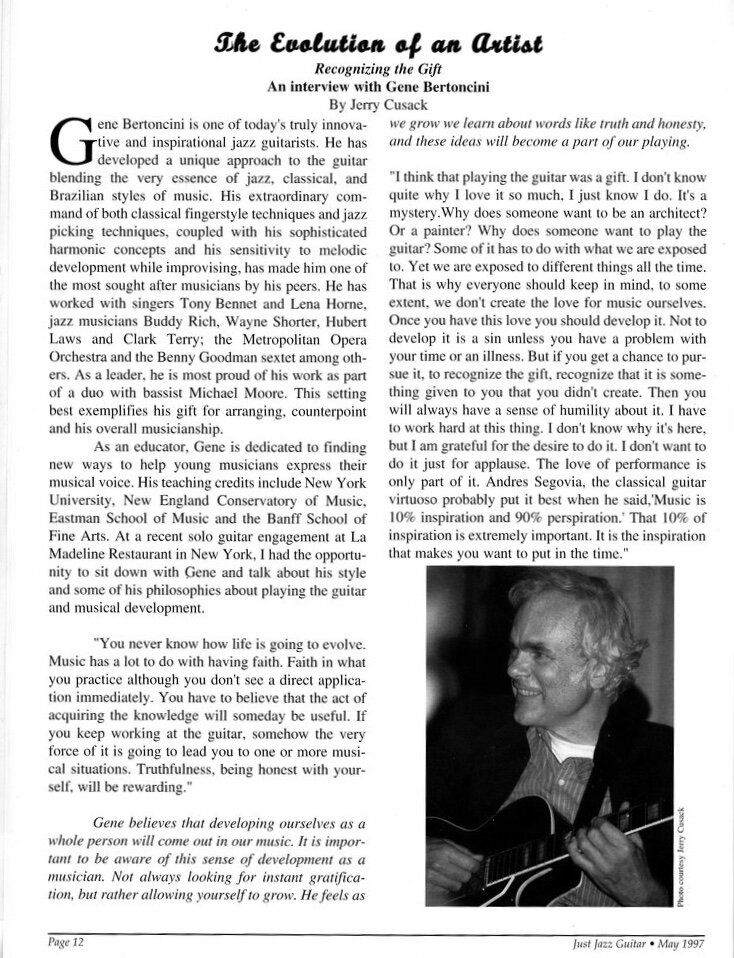
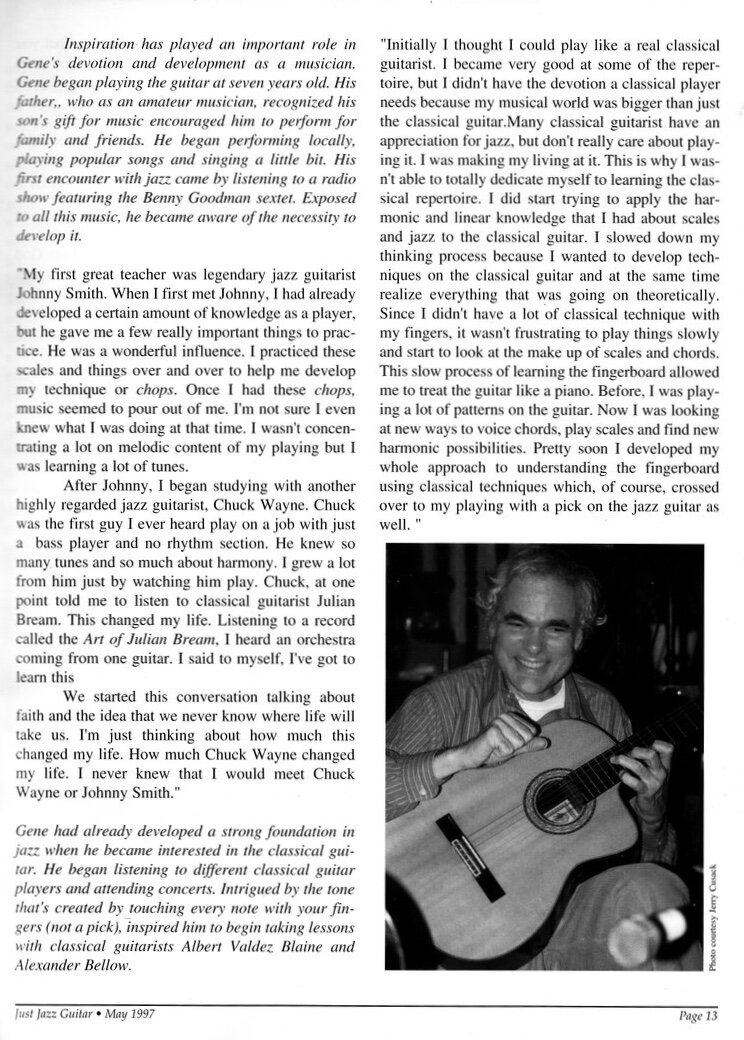
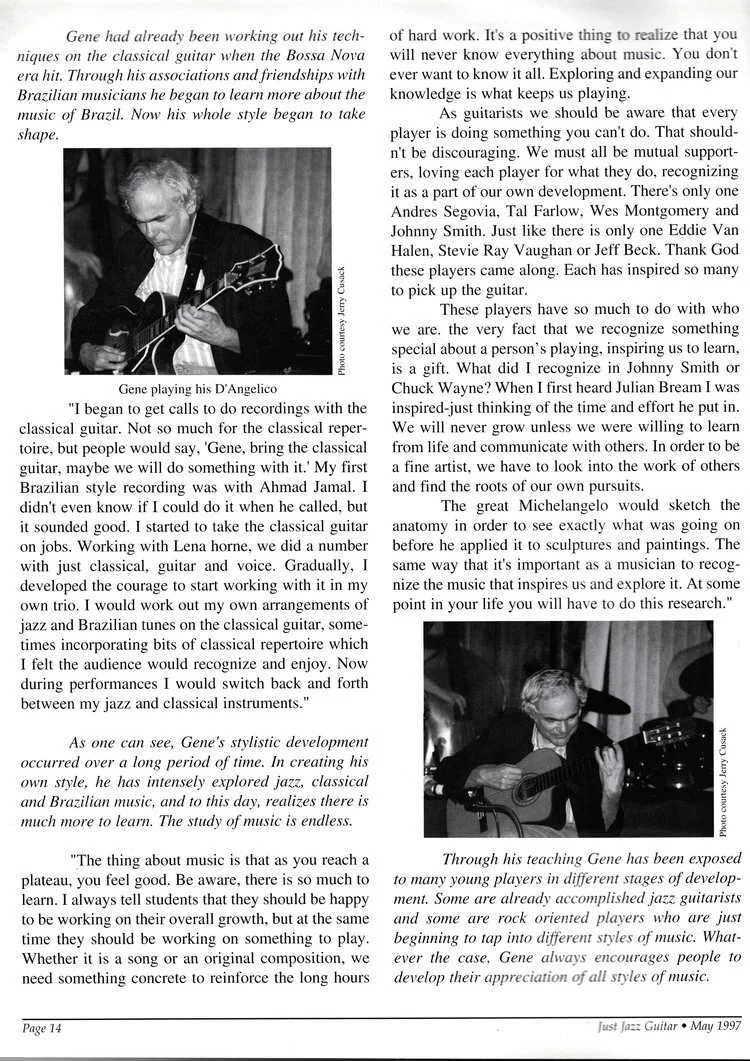
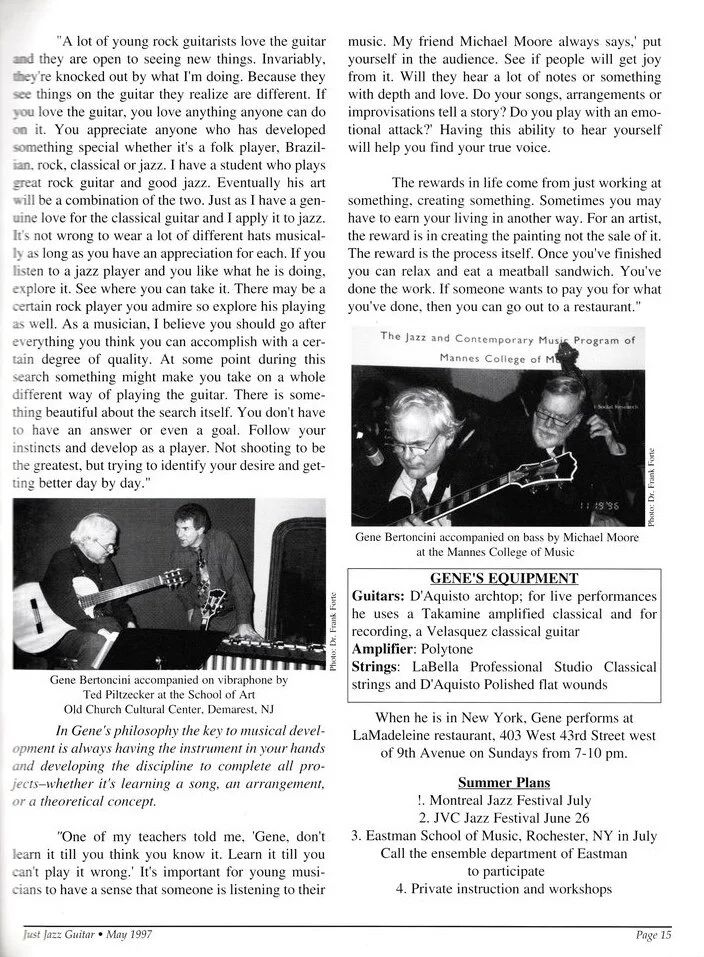
guitar player and instructor for all styles and music theory
The Evolution of an Artist, An interview with Gene Bertoncini by Jerry Cusack for Just Jazz Guitar Magazine, 1997




With the passing of Lee Konitz I thought I'd share a little of what he meant to me. This version of All the Things You Are is probably one of Lee's most recognized recorded solo's with the Lennie Tristano Quartet in 1955. The work he did with Warne Marsh and Lennie in those years was truly unique. He recognized, studied, and emulated his influences and then respectfully tried to be different. Never ending his search for the essence of the art of improvisation and inspiring others to seek out the same through his honesty and commitment to sharing music with people. One of my inspirations for sure. In the early years Lennie Tristano had a short list of artists that he felt his students should know their solos intimately like Lester Young, Charlie Parker, Charlie Christian, Roy Eldridge....and when asked who else he said Lee Konitz. You can find this solo transcribed everywhere I'm sure, but it's not about just reading it. It's listening to it until you can sing it and then working it out yourself discovering his motivic language, recognizing when he's paying respect to one of his influences by bending a familiar phrase. Knowing the chord progression and melody to the tune so well that his ideas speak to you. Studying with Lee. Wrestle with it do the best you can with the knowledge you have and grow from the experience. This picture is me doing just that. If you take any great soloist Charlie Parker, Bud Powell, Sonny Rollins, Miles Davis, Bill Evans, Paul Desmond, Hank Mobley, Wes Montgomery, Barry Harris, Tommy Flanagan, Donald Byrd, Lee Morgan....off the top of my head, and dig into one great solo on a blues or standard like All the Things You Are, with this spirit of discovery, you can find the essence of the thoughts and more importantly the practice of a great improvisor. Which solo is the right solo? Pick a player you love, pick a solo that moves you. Do the work yourself and the reward will be standing a little deeper in the pool of knowledge. I am inspired today to keep searching for that essence. The pursuit of knowledge and wisdom is a beautiful life. That's what I get from Lee Konitz.
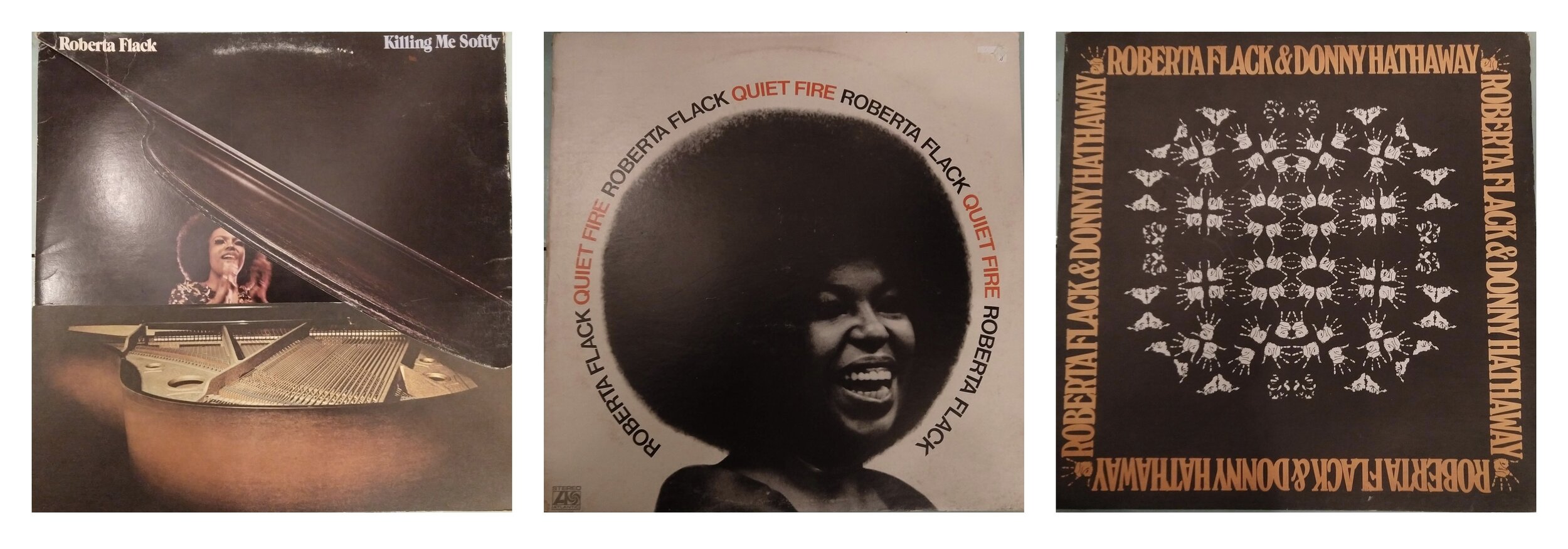
Last Thursday night Chris Medici hosted a chat about "Top 3 Concerts". I was teaching a lesson with one of our members at the time so I couldn't make it but wanted to share one of mine. Somewhere around 1995 or '96 I saw Roberta Flack was playing at an outdoor summer music series at a park in Oyster Bay, Long Island. The great jazz guitarist Larry Coryell was opening for her with a trio, whose playing and energy I always loved so I decided to go. The venue was a typical temporary outdoor stage set up with a large tent with rows of chairs for maybe 500 people and the rest could set up on the lawn picnic style with a little vino and listen through the sound system. I purchased a seat under the tent and got a seat close enough to the stage to check out Larry's playing. From what I remember Larry was his typical self. He always put together an interesting set of tunes to improvise over and let it all hang out. As an improviser he was never afraid to walk the razor's edge and that is what I admired.
I remember feeling very satisfied with Larry's performance and was really looking forward to hearing Roberta. I had grown up with her music in my house because of my father. He had three of her records that I still own and drop on the turntable frequently. (If you don't know her recordings with Donnie Hathaway check them out especially their duet of "You Lost that Lovin' Feeling". Every time I hear it I feel the passion that they put into their artistry.) It was a beautiful late summer evening in New York. August was always the hottest month but being in a park right off the Long Island Sound, there was a nice breeze and the sun was going down. By the time Roberta started it was getting dark. She had a full band, backup vocalists and herself playing a baby grand piano.
About 2 songs into the set the power went out. Not on the stage, but on Long Island. The stage was dark and everyone was sitting patiently waiting for them to take care of this technical difficultly. But as time passed and people started to realize that power was out everywhere, you could feel a little tension and a lot of chatter. Out by the lawn area there were a few lights from a temporary generator, just enough light to make out where you were. The beauty of this moment is that from the stage candles were being set up on the piano... who has a spare candelabra? Someone did. And the band members were holding individual candles. Everyone got real quiet and Roberta asked if everyone out on the lawn would come in and fill in any spots around the stage and isles. Within a few minutes the entire audience was under the tent sitting on the grass, on the stage or standing around the perimeter. The saying "you could hear a pin drop"... there was complete silence as she started to play the piano. The piano was very quiet trying to stretch its sound acoustically in the open air but soon you felt your ears adjust and really tune into the music. She played beautifully while the band sang back up and added what they could either with voice or acoustic instruments. The audience did not make a sound. I felt even the breeze took a gentler tempo as not to disturb the moment. I sat there feeling I was witnessing something very special. She was in complete control and had everyone in the palm of her hand as they say. I could feel her energy. We all could.
After about an hour or so the power came back on. I remember feeling disappointed as if the power coming back had intruded on this sacred place in time. I think everyone felt that. They finished an extra long set with the full band and seemed to be extra exhilarated from the experience, but that one hour without power was magical...the collective quiet was powerful.... humanity had a beautiful moment... and a single artist bent time and made life simple for a moment.

My oldest friend's son started playing sax and gravitated towards the baritone. His teacher recommend he start with alto and move up to baritone because of size. He said "sounds great... I'll take the bari". I love that he hears in that register and is following the nature of his own ear. So in his honor I spent the afternoon transcrbing one of my favorite baritonists, Ronnie Cuber's, gem on 'All of Me' off of George Benson's 'Cookbook' 1967. If you don't know this recording, it is a must. Although I love all of Benson's playing on his earlier recordings, the records 'Cookbook' and 'Uptown' put him in a category by himself as a guitarist and jazz stylist. I've been listening to them for 40 years and they are as fresh and vibrant as the first time I heard them. Now I have to transpose for Baritone.... Another day.

In thinking of a few classic solo's on an F blues I wanted to explore chronologically how particular classic solos, in combination, can influence and shape a musicians own improvisation and style. Wes Montgomery's brilliant Billie's Bounce solo, I feel, pays direct homage to both Charlie Christian and Charlie Parker. Charlie Christian's two chorus solo on Grand Slam (a.k.a. Boy meets Goy) in 1940, was sighted by Jim Hall to be one of his favorites. Jim felt that each phrase was a gem worthy of dissection. He often quotes this solo in his own playing. Check out Blackwell's Meeting on the Magic Meeting recording to hear his tip of the cap to Charlie's themes. In the first chorus Charlie weaves in and out of F major and minor pentatonic scales in first position creating his bluesy lines. A very guitaristic phrasing based on how it falls under your fingers. The second chorus introduces a bit more arpeggiation and chromaticism and falls nicely moving between 5th and 8th position. The melodic content of this solo is a classic and beautiful example of the time, but I feel it is the rhythmic playfulness of how phrases cross over the bar lines a la Lester Young, that shows how Charlie was on the cusp of the beginning of bebop.

I included Benny Goodman's solo on the same Grand Slam recording because as I was listening and preparing to transcribe Christian's solo. I started to fall in love with Benny's playing and could hear how he and Charlie were really listening to each other, speaking the same language. When I put this on the guitar it felt very much like Charlie's solo in terms of phrasing and rhythmic playfulness. I particularly love his phrase starting on the end of bar 4 through bar 7 chromatically ascending to the C suspended in air as the 9th of the Bb7 chord followed by descending octave jump on the b7 (Ab) ascending to the G and the descending into the F7 chord with an F major/minor pentatonic sound. The 5 note scale both he an Charlie use F G Ab C D which are the Root, 2, b3, 5, 6. An angular phrase like this I would extract to see what I could do with it. How would it work over different chords? Would it be an interesting sequence? Just a thought.

These 5 choruses by Charlie Parker are probably one of the most quoted solos in the repertoire. A complete gem where every phrase is its own lesson in improvisation. To begin to list the amount of solos that quote this moment in time would be endless. To think that this, approximately, one minute in 1945 has had that much impact on the direction of jazz immediately. Parker's peers picked up on the significance of his work and emulated it instantly. There are plenty of the examples of influential solos but this is definitely one of the essentials. In 1957 Lee Konitz recorded Billie's Bounce on his record Very Cool and at the end of the recording he and trumpeter Don Ferrara play the entire 5 chorus solo taking the tune out. Konitz mentor, Lennie Tristano, had his students memorize solos like this one in order to feel what it is like to play a masterpiece. Tristano's first step was to listen until you could sing it before transcribing. Once you know this solo from listening you will hear it everywhere, Sonny Stitt, Jimmy Heath, Lou Donaldson, Sonny Rollins, Jim Hall, Donald Byrd, Hank Mobley Kenny Durham. Everybody including Wes Montgomery which is the point of all this. Like I said every phrase deserves its own investigation, but the 9th and 10th bar of the second chorus, the blistering 16th note phrase over the G-7 to C7 is a highlight of the solo. Pulling that phrase apart slowly and understanding the usage of chromaticism and the angular arpeggiated construction is a worthy study. Parker knew his own phrases inside and out. Improvisation is not necessarily making something up on the fly, but more studying something until you can use it at will. Check out the same phrase on his classic Au Privave solo. The phrase starts in a different spot in the bar, has a few different turns, but the essence is from the same study. Parker was seamless melodically, rhythmically....everything.


Again here I include Miles Davis' solo from the same recording because as I was listening, preparing to transcribe this solo I heard a young Miles Davis emulating his hero Charlie Parker. The interesting thing about this solo is in listening to the other takes on the complete Savoy collection. You can hear how Miles is creating and studying his own phrases. Here is a young Miles developing his style which would evolve into that haunting liquid phrasing. Just the essentials. The right note at the right time. At this point he is playing a lot more, a busier style that he attributed to taking over for and emulating another on of his idols Dizzy Gillespie. Miles talks about making a conscious effort to let go of trying to play like Dizzy so he could become himself. These recordings of Miles are the beginning of him being an integral part of each change in stylistic direction over the next 40 years.

Wes Montgomery's solo here on Billie's Bounce, for me, really sounds like a bridge between Christian and Parker in his own style. Wes truly had his own language derived from these two masters who were self stated major influences on his playing. At the time of this recording on a record called Fingerpickin' in 1958 Wes would have been intimately acquainted with these solos. Wes was said to have learned all of Charlie Christians's solos by ear and would have most likely played Grand Slam. Like Tristano's teaching, Wes knew the importance of feeling what it was like to play a masterpiece. When I say feel, I think it means actually physical playing of, building technique, and feeling the soul of the melody through your ears. Getting inside a solo like these and coming out with an education. You can explore these solos at every level. I remember first listening and not knowing what was happening theoretically but getting caught up in the energy. Now I listen and think how far I have come to understand this language, and how much more is there to learn. What is the next level of understanding? The rungs on that ladder are endless. The first chorus is classic F blues scale material which played in 1st position on the guitar, have a very similar guitaristically phrased feeling like Christian. Again no direct quotes but energy, melodic ideas very much in the style of Charlie Christian and that time period when bebop is looming. The second chorus seems to Bridge the way between Christian and Parker. Bluesy phrases floating over the form mixed with arpeggio and scale phrases really outlining specific harmony. The third chorus to me is more Parker like in its fluid scale passages and very interesting rhythmic variety. Bar 7 through 10 have a very cool descending thirds line which each note has its lower chromatic neighbor in the middle giving an eight note triplet feel inside the 4/4 bar which shifts the accent as the idea crosses the bar lines in a very interesting way. You can hear it more than anything. It took me a good minute to work that out. Again here is an interesting spot to put the magnifying glass on and do some exploration. What would that feel like if you played a whole scale like that ? a Mode? Where would the accents fall? Fun stuff. One tiny idea that can spark a stylistic development in your own playing.

After listening and transcribing a great masters solo, Lennie Tristano would have students write there own solo. Write a solo that you would want to be able to improvise and then learn it the same why you did lets say Parker's Billies Bounce. Essential transcribing yourself. They don't have to be masterpieces they just have to be honest, sing a phrase and write it down. It should be cliché if you're learning the language. Don't think too hard, just sing. Learn the chorus, play it, play Parker's (as best you can). Work on understanding more theoretical content, practice chord scale relationships, arpeggios, form of the tune, play your chorus, play Parker. Then write another chorus you'd like to be able to improvise. Did you repeat some ideas? Anything new? Any quotes come up from your transcription of Parker? Keep doing it. Learn your own language. That's what a young Parker did, listen to him quoting the famous 1939 Coleman Hawkins solo on his Body and Soul solo with The Jay McShann Orchestra a few years later in the early 40's. Somebody said imitation is the greatest form of flattery. And the greatest way to learn apprenticing to the masters. These are three choruses that I wrote down with different students who are listening and playing these transcriptions. We worked them together by me asking, "Give me a chord tone to start on. Play it, play the chord, sing a little phrase. What direction do your hear it going? What's the next chord?" It's a great process to make a regular routine. It was the essence of the Tristano school. We are not reinventing the wheel, just honest singing. You'd be surprised how far honesty will take you. Never judge your ideas, this is a laboratory where the simplest phrase sparks many off shoots. This is why the minute you hear a player you've listened to, you can identify them instantly. That's Charlie Christian. That's Charlie Parker. That's Wes.



I left these hand written to show the process I go through. There is plenty of erasing. What I thought I heard one day, the next day I realize it is something different. Rhythmic phrase that you can't quite get, like the triplet feel in the third chorus of Wes' solo. The important thing I am stressing is that on one level it is fine to play a transcription someone else did. This way you get right to working on the solo reading it and analyzing it. But it is a whole other thing to do it yourself. Your ear develops in a way that is direct. If you know the tune, and know the basic theoretical concept of what might be the scale or arpeggio used over a certain chord, then you listen in order to take the phrase by ear, the essence of the jazz language is being absorbed at the root which is what you are hearing. Writing it down as best you can initially is the best way, I think, to learn to read better on your instrument and recognize rhythms on the page. Sometimes a tricky rhythm or a hard melodic or harmonic idea to hear will prompt you to dig deeper for the tools to understand. Like making you ask a question at a lesson, a question that might open up a new avenue of study. It's not important to be exactly right initially, or ever really, all that matters is you try. Your ear will grow, you will hear more deeply over time, and hear things you didn't realize were there. I did my best with these transcriptions, I've done a lot of them. Making these connections between players, extracting a little phrase that you love, studying it, that is the spice of the work. It's not necessary to always transcribe full solos. One phrase works, but come at it with as much knowledge that you have at the time. Do you know the original melody, the chords to the tune? Do you know the harmony of the bar in the form your are pulling the phrase from? At the end of the day listening to music is your most important teacher. Whenever I hear something I feel the need to listen to closer I put it on my list. And if you question, which is the right solo to transcribe ? The answer is all of them. Anything that catches your ear, your imagination, makes you want to pick up your instrument to find it. Needless to say my transcription list of things I should work on is ridiculous. But whenever I have a thought about how solos might link together like this, I'll put together a little project for myself. Like Christain, Parker, Montgomery with a side of Goodman and Davis on an F blues.